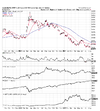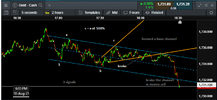- Joined
- 10 June 2007
- Posts
- 4,045
- Reactions
- 1,404
rug-pulls come from two different positsas someone liable to buy ( extra ) gold producer stocks in the coming month , the overnight drop certainly caught my eye
will the market buy the dip or rush to the sidelines , i wonder
sellers out pace buyers, simply by weight
but the hardest judgement to make is where the likelyhood that buyers simply retract their bids altogether
(time in and the timing to get in and get out)
this is the balance that assists the investors who are now getting likely frustrated by the constant yap from people like me
the balance is "time" is the most expensive component beyond what a fundamentalist point of view can assess
for example if investors bought the story of gold in 2010 and thru 2012 and 2013 and 2014 etc how long did they have to wait to get to par
everyone times the market, anyone who says they dont time the market is literally wasting time
if you say you only transact when value is correct then you are by definition of logic timing the market
ignoring the time factor is fine for a trader when levels dictate executing order flows and volume basis,
not for an investor altho most investors would disagree
time is the one aspect of everything that you cannot replace
a trade is executed to buy then executed to exit or executed to sell then to buy back
the difference between a fundamental approach versus a technical approach is merely reasoning
the question is not whether we are right in the decision making process, the question is this:
how do we know we didnt just get lucky with a positive result, how do we prove that a positive result was by repetitive design?
..are you making a strawman theory or a steelman theory
a strawman theory relies on the market to prove future outcome in the investors favour
a steelman theory relies on repetition of evidence for positive outcomes that make sense in the time period one has or can allow for
so investors who go in on the basis of fundamentals that ignore psychology or herding will only see these things when
the value is readjusted in their portfolio, too late, the values that took them in are ultimately dictated by the auction,
not by their logic about everything else, in extreme cases this does not apply, of course,
the question then (given that "extreme" is a timing thing too) which end of extreme are we in, the extreme end of value is stretched
new investors refuse price discovery, conversely, are we at an extreme (circa 2000) when price is too dumbly priced not to buy
or.....this is the big one, is the market merely reflecting that the price (as a cost of future value) out of step as an expression of what is now defined as valuable and how has that value be re-rated given the nature of the application of the underlying goods
you see the basic tenet of the value of the goods needs to be in-step (for or against) with that herding, price needs to reflect the correct level where we find value as a balance of expression, it is not your sense of the value that matters, it is the evidence you can prove that shows you are in-step with with everybody else is actually doing in the auction, given that the cup holders in your car embellished the price upwards (marked up) whereas, this year no one gives a toss about the same cup holders and your car is not re-selling at auctions like last year, but it will sell, at some price level, at some point in time, how much time do you want to allow?
again, an investor can lose everything by simply not participating, not taking any action is the "smart" thing to do when price is going in the right direction, how do you confirm that you have framed correctly ?
anyone who says herding and psychology misses the point in terms of book value, that, as an investor, you are part of that herding
i used to be different, now i'm the same
technical analysis is merely a stick to poke at the nest, a focal point, a very useful tool(s) for investors
when price is moving at range of clip, i mean, its transacting at a round-about-ish rate, i often say don't buy the easy buy or dont sell the easy sell, it's absolutely non-sensical thing to say, right(!) yet it's the psychology within the print that says someone is on the wrong side of
the money that has intent to use lazy-ness in their own favour (in other words, for example, when lazy feel good buyers are buying a slow dip it's often that theyre buying what someone banking and liquidity gangs assist in that action)
...the tulip/tea excursions would still have happened even with modern day technical analysis, we know this, because, crypto
technical analysis and fundamental analysis are merely focus of the same psychology,
all analysis is merely an outlet of expression, the excuse we use to fulfill the drivers we have yet few recognise consciously
one of my biggest trading and investments mistake was in 2000 when xauusd was circling 300USD
i didnt have the technical chops to spot the evidence, to put activity into context, to understand the relative size of what was printing
even tho i suspected gold may become a very desired commodity again and i should get on it, so i didnt, spotting a rotational point
is both time risk and capital risk, when people say you shouldnt pick tops and bottoms, well, in my humble opinion, not so(!), at some
point in the price print (your chart) or in the book value, an investor must agree on a where a bottom is or a top is, and that, by every construct of logic, is picking a top or a bottom, the practise place in seeing ALL the evidence and not just one focus defines how quickly
the correct decision can be executed, not worrying about being right or looking good, about effective outcomes, win or lose
...and these are just words on a page
coffee












